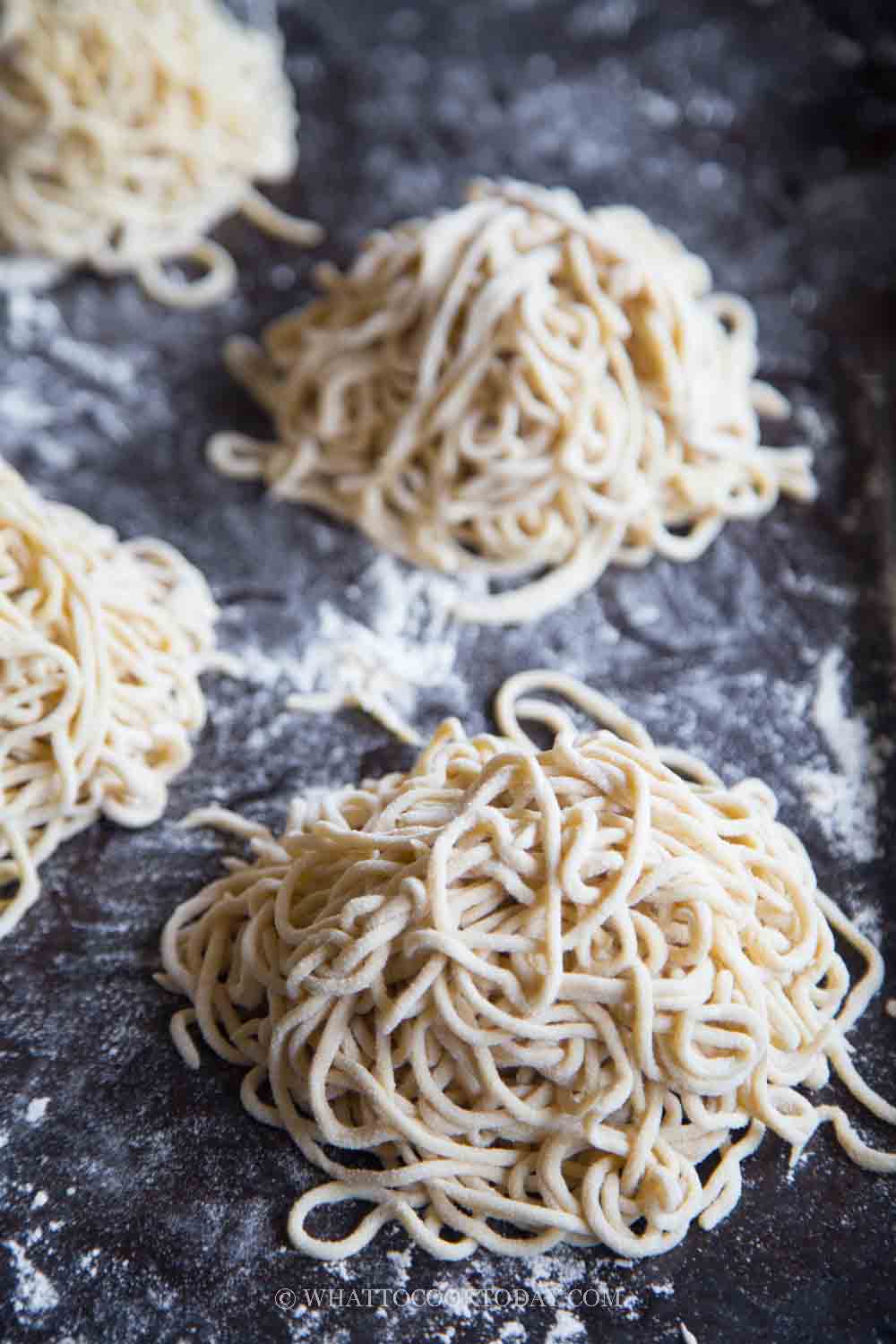Homemade Alkaline Noodles/Ramen Noodles (Jian Shui Mian)
5.0
(1)
Your folders
Your folders
Prep Time: 15 minutes
Cook Time: 2 minutes
Total: 77 minutes
Servings: 3

Ingredients
Export 3 ingredients for grocery delivery
Instructions
Step 1
In a large mixing bowl, whisk water, oil, egg (if using), and lye water to combine. Add the flour and salt. Stir with a chopstick at first to form uneven granules of flour mixture, then use your clean hands to mix into ragged-looking dough. As long as you can form a rough dough, eventhough if it's at a dry side, it's okay. This dough is meant to be at a dry side. Don't be tempted to add too much liquid.
Step 2
Cover the mixing bowl and let it rest for 1 hour
Step 3
After the 1-hour rest, the dough won't be as dry anymore. Use your clean hands to give it a few kneadings. It will smooth out more, but it won't be a perfectly smooth dough, which is what it supposed to be
Step 4
I use a pasta roller to get the job done much easier. I divide the dough into two masses. Cover the other and work with one at a time. Flatten the dough with a rolling pin, about 1/2-inch or a bit less so it can pass through the roller. Dust the flattened dough lightly with some flour. I use Kitchen Aid pasta roller and it has 8 settings. I start with setting no. 1, which is the thickest setting used to "knead" and thin the dough.
Step 5
Fold the dough in half and then pass through the roller. Repeat this step several times. Then reduce the setting to 2 and then fold the dough in half again lengthwise and pass through the roller. Do this maybe 2-3 more times. I actually stop at 2 because my kids like this thickness, but most people would reduce the thickness to one more level, which is setting no. 3.
Step 6
You are welcome to adjust the thickness the way you like it and with each setting, just fold the dough in half lengthwise and pass through the roller 2-3 times. Dust the noodle sheet with some flour
Step 7
Repeat with another dough to roll into dough sheets
Step 8
If you plan to cook the noodles right away, bring a large pot of water to a boil before you start cutting the noodles. Make sure you have a large pot of water. If you cook the noodles in too little water, the noodles will come out having a glue-like texture and very starchy. So you want to make sure the water is boiling and the amount of the water is enough to cook the noodles to get rid of the extra flour we dusted on the dough when we prepare the dough
Step 9
Liberally dust the noodle sheets with some flour to prevent the noodle strands from sticking to each other during cutting. I use the spaghetti cutter. Pass the noodle sheet through the cutter and catch the noodles as it comes out from the cutter. Dust with some flour to prevent sticking
Step 10
The large pot of water should have come to a full boil by now. Add a pinch of salt. Loosen the noodle strands using your hands and add them into the boiling water and use a chopstick to gently loosen the noodles to prevent them from clumping to each other. Let the water comes back to a boil and cook for another minute. The total cooking time would be about 3 minutes or less. It is important not to overcook the noodles
Step 11
Drain the cooked noodles through a heat-proof colander or strainer. Rinse the noodles through a cold running water to stop the cooking process and to remove extra starches. You can toss the cooked noodles in a bit of oil
Step 12
The cooked noodles are ready to be used, for mixing with sauces, stir-frying, or noodle soup
Step 13
For this recipe, I separate the cut noodles into about 4 separate piles. I place them on a baking sheet lined with parchment paper. Put them in a freezer to flash freeze them for about 1 hour. It won't be completely frozen but they are firmed enough to be transferred to a freezer bag or container. Push all the air out if using a freezer bag, seal the bag and store in the freezer for up to 1 month
Step 14
I do not recommend storing the uncooked noodles in the refrigerator as the noodles can get mushy because of moisture accumulates
Step 15
It's similar to the cooking step above, which is bringing a large pot of water to a boil. You don't need to thaw the frozen noodles
Step 16
Important tips: when cooking frozen noodles, remember not to "stir" the noodles the first 10-15 seconds when you just drop the noodles into the water. Because the noodle is still frozen and break easily. Stirring it will break the noodles into little pieces, which you don't want
Step 17
After that you can use a chopsticks to gently loosen the noodles a bit to separate them so they won't clump all together. Continue cooking until the water comes to a boil again and cook for another minute. Do not overcook the noodles
Step 18
Drain the cooked noodles through a heat-proof colander or strainer. Rinse the noodles through a cold running water to stop the cooking process and to remove extra starches. You can toss the cooked noodles in a bit of oil
Step 19
The cooked noodles are ready to be used, for mixing with sauces, stir-frying, or noodle soup